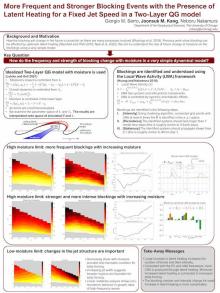More Frequent and Stronger Blocking Events with the Presence of Latent Heating for a Fixed Jet Speed in an Idealized QG model
Giorgio
Sarro
The University of Chicago
Poster
Building upon previous studies that examined the connection between upstream precipitation and blocking events, we explore the influence of moist processes on these events using a two-layer moist quasi-geostrophic model (Lutsko and Hell, 2021).
Our investigation focuses on whether the presence of latent heating in the QG model affects the frequency and persistence of blocking events. To identify these events, we utilize anomalies in deep anticyclonic local wave activity (LWA-A) (Nakamura and Huang, 2018), clustering regions of deep LWA-A that interrupt the midlatitude jet. By doing so, we assess the impact of latent heating on the occurrence, duration, and extent of blocking events, while also conducting an analysis of the energetic aspects of their formation using the LWA budget. This analysis disentangles the contributions of dry dynamics and moist effects.
Our findings reveal that, with a fixed jet speed, minor increases in latent heating have no significant effect on blocking frequencies. However, substantial latent heating results in increased blocking frequency and intensity. Latent heating plays a pivotal role in the formation of blocks by directly injecting LWA upstream of the block, while also influencing the dry dynamics of the entire jet stream.
Our investigation focuses on whether the presence of latent heating in the QG model affects the frequency and persistence of blocking events. To identify these events, we utilize anomalies in deep anticyclonic local wave activity (LWA-A) (Nakamura and Huang, 2018), clustering regions of deep LWA-A that interrupt the midlatitude jet. By doing so, we assess the impact of latent heating on the occurrence, duration, and extent of blocking events, while also conducting an analysis of the energetic aspects of their formation using the LWA budget. This analysis disentangles the contributions of dry dynamics and moist effects.
Our findings reveal that, with a fixed jet speed, minor increases in latent heating have no significant effect on blocking frequencies. However, substantial latent heating results in increased blocking frequency and intensity. Latent heating plays a pivotal role in the formation of blocks by directly injecting LWA upstream of the block, while also influencing the dry dynamics of the entire jet stream.

Poster file
Sarro_Giorgio_Blocking_Poster.pdf
(572.94 KB)
Meeting homepage
